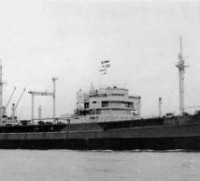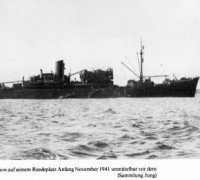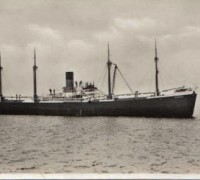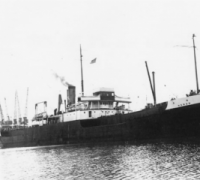- SHIPS TANKERS
9)SUPPLY SHIP PASSAT
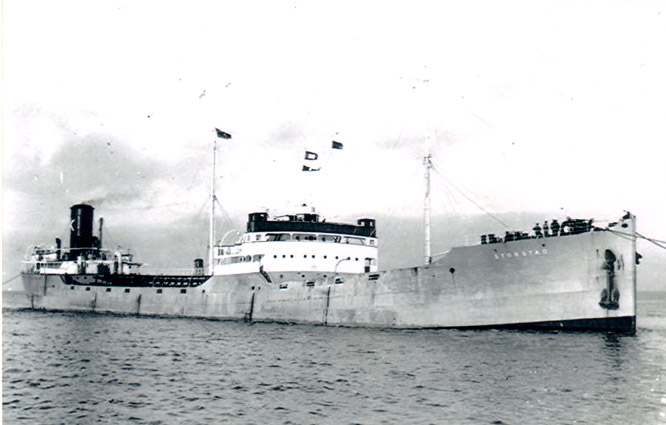
Passt seen as Storstad. Photo Storstad.jpg (666×425) (wikimedia.org)
Launched 21 October 1925
Tonnage 8,998 GRT/13,460 DWT
Length 148,7
Beam 18,95
Draught 8,83
Powerplant 12-Cylinder four-stroke diesel engine
Speed 11,5kts (Max)
Propeller (2)
Decommissioned May 4, 1943
The Storstad was in East Asia during the German invasion of Norway. In May 1940 the Norwegian government-in-exile placed it under the management of the Norwegian Shipping & Trade Mission (Nortraship), which was newly formed for the duration of the war.
Hijacking
On September 30, 1940, under the charter of Socony Vacuum Oil Co., the Storstad ran under Captain Egil Wilhelmsen from Miri in North Borneo with destination Melbourne, loaded with 12,000 tons of diesel oil and 500 tons of lubricating oil. On October 7th, she was sighted near Christmas Island by the German auxiliary cruiser Pinguin under Captain Ernst-Felix Krüder and forced to stop by a warning shot. Krüder intended to lay mines in six shipping lanes off Australia and Tasmania , but needed two ships. He took possession of the Storstad as a prize and ran with her to a remote area between Java and the north-western tip of Australia, where it took three days to convert it into an auxiliary mine ship, with a mine deck and mine rails on the aft ship. 110 mines were reloaded onto the Storstad with a motorboat from the Norwegian freighter Morviken, which was sunk on August 26th.
The Pinguin took over 1200 tons of diesel fuel, and then the prize was put into service under the name Passat for the Navy. Her commander was Erich Warning, temporarily appointed captain lieutenant ( S ) for the duration of the planned mine-laying operation . The remaining crew consisted of three officers, eight non-commissioned officers and 19 men, as well as five men from the original Norwegian crew, who had agreed to continue working in the engine room.
Auxiliary mineship Passat
On October 12th, the Passat ran into the waters between Tasmania and mainland Australia and from October 28th to November 7th put its mine barriers in the Banks Strait between the northeast end of Tasmania and the Furneaux Group and at the east and west exits the Bass Strait , at Wilson's Promontory and on Cape Otway, on the access roads to Melbourne.
The Pinguin, meanwhile, threw its mines off Sydney, Newcastle, Hobart and Adelaide. Both ships were completely silent during this month-long venture.
The Passat mines claimed at least two victims. On November 7, the reefer ship Cambridge (10,846 GRT) ran at the eastern end of Bass Strait on a mine of the Passat and sank; a man was killed. On November 9, the American freighter City of Rayville (5883 GRT) sank at the west end of Bass Strait after being hit by mines; here too a man of the occupation was killed. The City of Rayville was the first American ship sunk by German action during World War II.
Blockade breaker Storstad
The Pinguin and the Passat met again on November 15, as agreed, about 600 nautical miles west of Perth . There the Passat was renamed Storstad again on the following day and withdrawn from the Navy in order to initially serve as a reconnaissance aircraft for the auxiliary cruiser until all of the fuel still in the tanks could be delivered to other German ships. Their German crew was reduced to 18 men, and another 20 Norwegians volunteered to join the five already on board. From November 19, the two ships then ran south-west of Australia with some distance on a parallel course in order to have a wider field of vision. In the following eleven days, four ships were tracked down and sunk by the Pinguin.
On 8./9. December the two ships met around 900 nautical miles southeast of Madagascar with the auxiliary cruiser Atlantis . After the two auxiliary cruisers had once again taken over fuel from the Storstad , the prize with the total of 405 prisoners of the two auxiliary cruisers was released to Germany on the morning of December 10th under Lieutenant for the Sea Helmut Hanefeld.
In the last week of December, the Storstad , who had circled the Cape of Good Hope disguised as the Norwegian tanker Falkefjell, on 06 Aug 41 met in the South Atlantic on pos. 27º 00'S, 12º 00'W with the heavy cruiser Admiral Scheer , the supply ship Nordmark , the auxiliary cruiser Thor, the tanker Eurofeld and the Prize Duquesa , in turn 6,500 tons of fuel were delivered and another 119 prisoners from the Admiral Scheer and the Nordmark were taken. From January 6th to 8th, the Storstad handed over the rest of its diesel oil load to the Nordmark and then went on the last section of its journey home. On February 4, 1941, she reached Le Verdon on the Gironde in western France.
Supply ship Passat
The ship was recorded on February 16 by the Navy Service (KMD) Bordeaux for the supply ship association and placed under the West Group with the KMD Bordeaux. On February 25th, it was approved by the Hamburg Prize Court for use by German authorities. On February 27, it was renamed the Passat again and finally assigned to the supply ship association. The ship management was carried out by the First German Whaling Society .
On April 1, 1941, the Ateliers & Chantiers de Bretagne (ACB) shipyard in Nantes began converting it into an auxiliary ship. On February 1, 1942, it was put into service under Captain Otto Kölschbach. After the final equipment was completed, the Passat was transferred to Saint-Nazaire , where it was badly damaged on March 29 at the British commando against Saint-Nazaire, the " Operation Chariot ". After the explosion in Campbeltown , she was rammed in the stern at the lock gate by Schlettstadt , which was behind her , which had been torn from its mooring when the lock was forcibly partially opened, and then lay blocked in the lock. On April 18, it was damaged there again by British aerial bombs.
Passat blockade breaker
After the repairs had been completed, it was moved back to Nantes in June 1942 for the final equipment. However, she was no longer to serve as a supply ship, but as a blockade breaker and supply the auxiliary cruiser Thor on the voyage to Japan . The ship was supposed to leave for Japan on September 6th, but on the morning of September 2nd in the inner roadstead of Saint-Nazaire, where the MES system had been reset , it was severely damaged by a bomb hit in the engine room during a British air raid 80 deaths were to be mourned. In September it was moved back to Nantes, where the entire crew and equipment were handed over to the Brake, which then left on September 13 with the original order of the Passat .
The End
On May 4, 1943, the Passat was taken out of service. She was later without crew at Donges in Loire next to the also badly damaged North Star launched and soon to be released to the cannibalizing. Accordingly, on December 10, 1943, the supply ship association Group West handed it over to the Nantes branch of the Paris supply department of the Wilhelmshaven naval shipyard . During the German withdrawal from Nantes, the ship was self- sunk on August 11, 1944 . The wreck was lifted and demolished in 1949.
By Storstad (ship, 1925) - zxc.wiki
